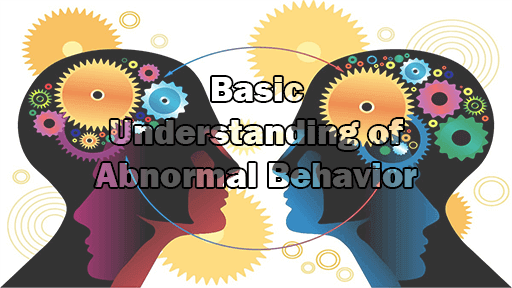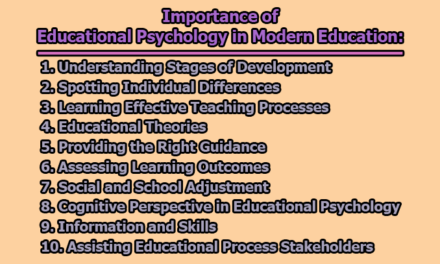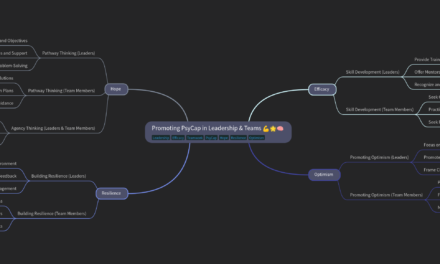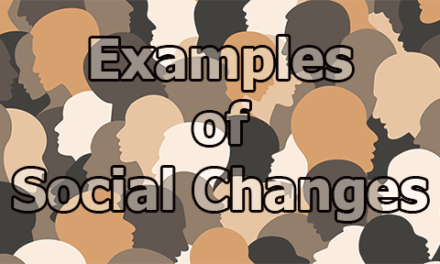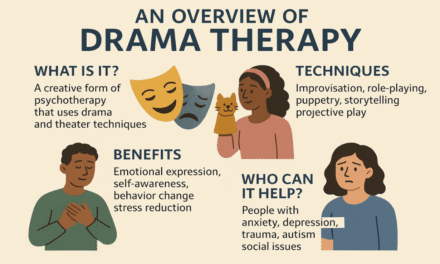Basic Understanding of Abnormal Behavior:
Abnormal psychology is the branch of psychology that studies unusual patterns of behavior, emotion and thought, which may or may not be understood as precipitating a mental disorder. Although many behaviors could be considered abnormal, this branch of psychology generally deals with behavior in a clinical context. In this article we will explore the basic understanding of abnormal behavior: criteria, classification, causes, and treatment of abnormal psychology
What is Abnormal Behavior?
Abnormal behavior refers to patterns of thought, emotion, or action that deviate from what is considered typical, expected, or socially acceptable, often causing distress or impairment in daily functioning. This term is commonly used in the field of psychology to identify behaviors that may indicate a mental disorder or psychological distress. Abnormal behavior can manifest in various forms, including statistically atypical actions, violations of cultural norms, maladaptive behaviors, emotional distress, impaired judgment, and deviations from ideal mental health standards.
Four Criteria of Abnormality:
In the field of abnormal psychology, psychologists often utilize four criteria to define and identify abnormal behavior. These criteria provide a framework for evaluating whether a particular behavior is within the range of typical or expected functioning, or if it deviates significantly from the norm. Each criterion contributes to a comprehensive understanding of what constitutes abnormality:
1. Statistical Deviation: Statistical deviation is based on the idea that abnormal behavior can be identified by its rarity or infrequency within a population.
Explanation: If a particular behavior is statistically uncommon or deviates significantly from the average, it may be considered abnormal. This criterion relies on statistical analysis to determine the frequency of a behavior within a given population.
Example: Consider a population where most individuals experience mild anxiety, but one person exhibits extreme anxiety levels that are statistically rare. In this case, the high level of anxiety might be considered abnormal based on statistical deviation.
2. Violation of Cultural Standards: This criterion suggests that behaviors that violate societal or cultural norms are considered abnormal.
Explanation: Societies establish certain norms and expectations for behavior based on shared values, beliefs, and customs. Behaviors that deviate from these cultural standards may be labeled as abnormal.
Example: In some cultures, certain religious practices involve rituals like speaking in tongues or handling snakes. While these actions may be acceptable in those cultural contexts, they might be considered abnormal in societies where such practices are not the norm.
3. Maladaptive Behavior: Maladaptive behavior refers to actions that interfere with an individual’s ability to function effectively in daily life or that cause harm to oneself or others.
Explanation: The focus here is on the impact of behavior on an individual’s overall well-being and their ability to cope with environmental stressors. Maladaptive behaviors hinder an individual’s functioning and may lead to distress.
Example: A person struggling with substance abuse may engage in maladaptive behavior as the use of substances impairs their daily functioning, relationships, and overall health.
4. Emotional Distress: This criterion involves assessing whether a behavior is accompanied by significant emotional distress or suffering.
Explanation: Abnormal behaviors often cause emotional turmoil for the individual involved. If a person consistently experiences feelings of anger, anxiety, fear, or depression, it may indicate abnormality, especially if these emotions are intense and pervasive.
Example: A persistent and overwhelming sense of sadness or anxiety that significantly impacts an individual’s daily life and well-being may be considered abnormal due to the emotional distress associated with the behavior.
It’s important to note that these criteria are often used in combination, and the determination of abnormality is context-dependent, considering cultural, societal, and individual factors. Additionally, the interpretation of abnormal behavior is subjective and may vary across different cultural and societal contexts.
Classification of Abnormal Behavior:
The classification of abnormal behavior is a crucial aspect of abnormal psychology, aiding in the systematic understanding and diagnosis of various mental disorders. Two widely recognized classification systems are the Diagnostic and Statistical Manual of Mental Disorders (DSM) and the International Classification of Diseases (ICD). The classification process involves organizing abnormal behaviors into categories based on shared characteristics, symptoms, and underlying factors. Here is a brief exploration of the classification of abnormal behavior:
1. Diagnostic and Statistical Manual of Mental Disorders (DSM-5): The DSM is an authoritative classification system widely used by mental health professionals in North America. The fifth edition, known as DSM-5, provides a comprehensive framework for diagnosing mental disorders and includes criteria for identifying and classifying abnormal behaviors.
Elements of Diagnosis:
- Behavioral, Thoughts, or Emotional Disturbances: The DSM-5 identifies mental disorders based on observable disturbances in behavior, thoughts, or emotions.
- Personal Distress or Impairment: Symptoms associated with personal distress or impairment are considered indicative of a mental disorder.
- Internal Dysfunctions: Symptoms should stem from internal dysfunctions, including biological and/or psychological roots.
Classification Axes (No Longer Used):
- The DSM-5 originally utilized a multi-axial system (Axes I to V) to assess various aspects of a patient’s condition. However, the current edition has moved away from this system.
- Axis I: Clinical disorders, including major mental and learning disorders.
- Axis II: Personality Disorders and intellectual disabilities.
- Axis III: General medical conditions and physical disorders.
- Axis IV: Psychosocial/environmental problems contributing to the disorder.
- Axis V: Global Assessment of Functioning (GAF).
Categorical Approach: The DSM-5 adopts a categorical approach, classifying disorders into distinct categories. Each category has specific criteria that must be met for a diagnosis.
Specific Disorders: The DSM-5 lists and describes a wide range of mental disorders, such as Major Depressive Disorder, Generalized Anxiety Disorder, Schizophrenia, and Substance Dependence.
2. International Classification of Diseases (ICD-10): The ICD-10 is a globally recognized classification system developed by the World Health Organization (WHO) and covers a broad range of health conditions, including mental and behavioral disorders.
Chapters: Mental and behavioral disorders are covered in Chapter 5 of the ICD-10.
Main Categories: The ICD-10 classifies mental disorders into several main categories, each with specific subcategories. Some of these categories include:
- F00–F09: Organic, including symptomatic mental disorders.
- F10–F19: Mental and behavioral disorders due to psychoactive substance use.
- F20–F29: Schizophrenia, schizotypal, and delusional disorders.
- F30–F39: Mood [affective] disorders.
- F40–F48: Neurotic, stress-related, and somatoform disorders.
- F50–F59: Behavioral syndromes associated with physiological disturbances and physical factors.
- F60–F69: Disorders of adult personality and behavior.
- F70–F79: Mental retardation.
- F80–F89: Disorders of psychological development.
- F90–F98: Behavioral and emotional disorders with onset usually occurring in childhood and adolescence.
- F99: Unspecified mental disorder.
Concordance with DSM: The ICD-10’s mental and behavioral disorders chapter has been influenced by the DSM-IV, and there is a significant level of concordance between the two systems.
Global Applicability: The ICD-10 is widely used internationally for health statistics, epidemiology, and billing purposes, providing a standardized system for classifying mental disorders.
Causes / Perspectives on Abnormal Behavior:
Abnormal behavior can be attributed to various causes / perspectives or models attempt to explain the complexity of why individuals may exhibit behaviors that deviate from the norm. These perspectives provide frameworks for understanding abnormal behavior from different angles, encompassing biological, psychological, and social factors. Here is an exploration of the causes / perspectives on abnormal behavior:
1. The Medical Perspective:
Focus: The medical perspective emphasizes biological and physiological factors as the primary causes of abnormal behavior.
View: Abnormal behavior is considered a disease or mental illness, diagnosed through symptoms, and treated with medical interventions such as medications and hospitalization.
Supporting Research: Advances in neuroscience linking biochemical disorders to certain abnormal behaviors have strengthened the medical perspective.
2. The Psychodynamic Perspective:
Focus: Rooted in Freudian psychoanalytic theory, this perspective suggests that unconscious conflicts and unresolved issues contribute to psychological disorders.
View: Abnormal behavior is seen as a manifestation of anxiety resulting from unconscious conflicts. Treatment involves identifying and resolving these conflicts through psychoanalysis.
Supporting Research: Case studies and clinical observations form the basis for psychodynamic theories, though empirical support may vary.
3. The Behavioral Perspective:
Focus: The behavioral perspective attributes abnormal behavior to faulty or ineffective learning and conditioning.
View: Maladaptive behavior is learned, and treatment aims to reshape disordered behavior through classical and operant conditioning.
Supporting Research: Experimental studies, including those on classical and operant conditioning, support the role of learning in the development of abnormal behavior.
4. The Cognitive Perspective:
Focus: The cognitive perspective posits that abnormal behavior results from specific thoughts and behaviors, often based on distorted or irrational cognitions.
View: Treatment aims to modify maladaptive thought processes, helping individuals develop new cognitive patterns.
Supporting Research: Studies on cognitive biases, errors, and cognitive restructuring provide evidence for the influence of cognitions on behavior.
5. The Social-Cultural Perspective:
Focus: This perspective emphasizes the impact of social and cultural factors on the development of abnormal behavior.
View: Abnormal behavior is learned within a social context, with cultural variables playing a crucial role. Societal norms and values contribute to the definition of abnormality.
Supporting Research: Cross-cultural studies and observations on the influence of cultural factors on specific disorders, like eating disorders, support the social-cultural perspective.
Treatment of Abnormal Psychology:
The treatment of abnormal psychology involves a range of therapeutic approaches aimed at alleviating symptoms, improving functioning, and enhancing overall mental well-being. These approaches are diverse, reflecting the complexity of mental health issues and the individualized nature of psychological disorders. Here is a brief exploration of various treatment modalities within abnormal psychology:
1. Psychoanalytic/Psychodynamic Therapy: Rooted in Freudian psychoanalytic theory, this long-term, insight-oriented therapy explores unconscious conflicts and unresolved issues contributing to abnormal behavior.
Techniques: Free association, dream analysis, and transference are common techniques used to explore and resolve unconscious conflicts.
Duration: Typically, psychoanalytic therapy is long-term and may extend over several years.
2. Behavioral Therapy: Behavioral therapy focuses on modifying maladaptive behaviors through learning principles, emphasizing observable actions.
Techniques: Classical conditioning, operant conditioning, systematic desensitization, and exposure therapy are employed to change behavior patterns.
Duration: The duration varies, but many behavioral interventions are relatively short-term.
3. Cognitive-Behavioral Therapy (CBT): CBT integrates cognitive and behavioral approaches, targeting both maladaptive thoughts and behaviors.
Techniques: Cognitive restructuring, behavioral modification, and exposure are used to address distorted thinking patterns and encourage adaptive behaviors.
Duration: CBT is often short-term, consisting of a limited number of sessions.
4. Humanistic Therapy: Humanistic therapies, such as client-centered therapy, focus on personal growth, self-actualization, and the development of an individual’s full potential.
Techniques: Active listening, empathy, and unconditional positive regard create a supportive therapeutic environment.
Duration: The duration can vary, and the therapy may be short or long-term depending on the individual’s needs.
5. Existential Therapy: Rooted in existential philosophy, this therapy explores issues related to meaning, freedom, responsibility, and the search for purpose in life.
Techniques: Reflective exploration, philosophical discussion, and confronting existential concerns are central to this approach.
Duration: Varies based on individual progress and the depth of existential exploration.
6. Group Therapy: Group therapy involves the simultaneous treatment of multiple individuals within a group setting, providing a supportive and social context.
Techniques: Group discussions, interpersonal interactions, and shared experiences contribute to therapeutic benefits.
Duration: Groups may meet regularly over an extended period, fostering a sense of community and mutual support.
7. Medication: Psychotropic medications, such as antidepressants, antipsychotics, and mood stabilizers, are prescribed to alleviate symptoms associated with certain mental disorders.
Techniques: Medication management involves finding the most effective dosage and type of medication for an individual’s specific condition.
Duration: Medication may be prescribed for varying durations, depending on the nature and severity of the disorder.
8. Electroconvulsive Therapy (ECT): ECT involves the controlled induction of seizures through electrical stimulation of the brain and is used in severe cases of depression or certain other disorders.
Techniques: ECT is administered under general anesthesia, and a series of treatments may be prescribed.
Duration: The number of ECT sessions depends on the individual’s response and treatment goals.
In conclusion, abnormal psychology provides a comprehensive lens through which to understand and address deviations in behavior, emotion, and thought. From the attempts to control deviant behaviors to the contemporary diagnostic criteria and treatment modalities, this field continues to evolve. By exploring diverse perspectives and embracing a multidimensional approach, psychologists can better comprehend and address the complexities of abnormal behavior, contributing to the well-being of individuals facing psychological challenges.

Assistant Teacher at Zinzira Pir Mohammad Pilot School and College

